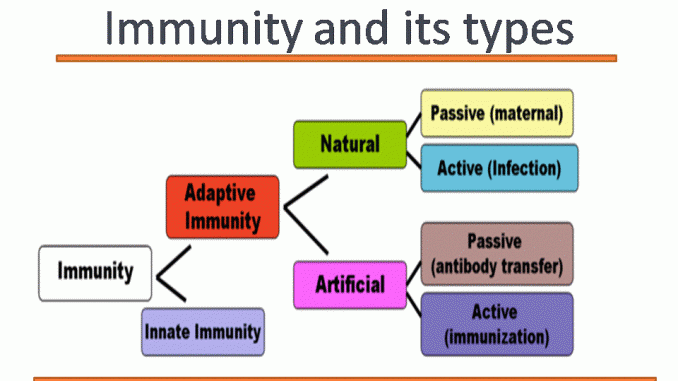
Immunity and its types: Innate and Acquired immunity
- Immunity is derived from Latin word “immunis” which means free from burden. In this case burden refers to disease caused by microorganisms or their toxic products.
- Therefore Immunity is defined as the state of resistance or in susceptibility to disease caused by particular microorganisms or their toxic products. For example some individuals having genetic deficiency of glucose-6-phosphate dehydrogenase are resistant to malaria. Such individuals are said to be immune to Plasmodium.
Types of immunity:
Broadly there are two types of immunity.
- Innate or natural immunity
- Acquired immunity
Innate or Natural immunity:
- Immunity with which an individual is born is called innate or natural immunity.
- Innate immunity is provided by various components such as Skin, mucus membrane, Phagocytic cells etc
- Innate immunity acts as first line of defense to particular microorganisms.
Mechanism of innate immunity:
- Anatomical barrier
- Physicochemical barrier
- Phagocytic barrier or Phagocytosis
- Inflammatory barrier or Inflammation
Types of innate immunity:
- Species immunity
- Racial immunity
- Individual immunity
1. Species immunity:
- If one species is resistant to certain infection and the other species is susceptible to the same infection then it is called as species immunity.
- Anatomic, physiological and metabolic differences between species determine species immunity. For example, Birds are resistant to anthrax but Human are susceptible. It is simply because higher body temperature of birds kills Bacillus anthracis.
- Anatomic differences between species also determine species immunity. For example, Human are more susceptible to skin infection whereas Cattles are more resistant to the same skin infection. It is because of tough and hairy skin (hides) of Cattles.
2. Racial immunity:
- If one race is susceptible while other race is resistant to same infection, then it is called Racial immunity.
- For examples; certain African race are more resistant to malaria and yellow fever where are Asian or Americans are susceptible to same infection. Similarly Orientals (East Asia) are relatively resistant to syphilis.
- Racial immunity is determined by difference in Socio-economic status, habitat, culture feeding habits, environments, genetic, etc.
3. Individual immunity:
- If one individual of certain race or cast is resistant while other individuals of same race or cast are susceptible to certain infection, then it is called as individual immunity
- Individual immunity is determined by various factors such as health status, nutritional status, previous illness, personal hygiene, genetic differences etc.
- For examples; Individual with genetic deficiency of glucose-6 phosphate dehydrogenase are resistant to Malaria.
Acquired or Developed immunity:
- Immunity which is developed later in life after microbial infection in host is called as Acquired or developed immunity. For example, If an individual is infected with chicken pox virus, he/she become resistant to same virus in later life.
- Acquired immunity is provided by Antibodies and certain T-lymphocytes.
- Components of acquired immunity such as Antibodies and T- cells are specific to particular microorganism. Therefore acquired immunity is also known as Specific immunity.
Characteristics of Acquired immunity:
- Specificity
- Self/non-self recognition
- Immunological memory
- Diversity
Types of acquired immunity:
- Active immunity
- Passive immunity
1. Active immunity:
- If host itself produces antibodies, it is called active immunity.
- It is of two types; artificial active immunity and natural active immunity.
- Artificial active immunity: Immunity provided by vaccination.
- Natural active immunity: immunity provided by natural infection.
2. Passive immunity:
- If host does not produce antibodies itself but antibodies produced in other host provides immunity, than it is known as Passive immunity.
- It is of two types; natural passive immunity and Artificial passive immunity
- Natural passive immunity: IgG antibody produced in mother cross placenta and protects fetus up to 6 month old age.
- Artificial passive immunity: if preformed antibody are injected into host for immunity. Eg. Anti-venom, Rabies vaccine (* it is not a vaccine, it is preformed anti rabies antibody)
